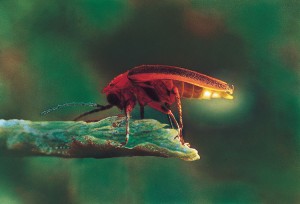Vanishing Flying Insects
Friday, November 10th, 2017November 10, 2017
Last month, in October, scientists in Germany warned that flying insect populations are rapidly declining. A study published in the scientific journal PLOS One revealed that about 75 percent of the flying insects in German nature preserves have disappeared in less than 30 years. The decline in natural areas of Germany could spell doom for flying insects—and many other forms of life—around the world. Quick action is needed to stem this decline, a serious matter referred to somewhat less seriously as the “windshield phenomenon” by some biologists (meaning there are fewer dead bugs to clean off automobile windshields these days).

A recent study showed alarming reductions in populations of flying insects, a group of animals that includes bees, butterflies, dragonflies, mosquitoes, and fireflies (pictured here). Credit: WORLD BOOK photo by Don Stebbing
Scientists have described and named more than 1 1/2 million species (kinds) of animals. Of these, about 1 million are insects. Scientists discover thousands of new insect species every year, and they believe there are many more yet to be found. Insects form the basis of many thousands of food chains. About 60 percent of birds rely on insects as part of their diet, and many types of bats, fish, spiders, and other animals also rely heavily on insects. In addition, about 80 percent of wild plants rely on insects for pollination. Without insects, many of these animals and plants would die. Without those plants and animals, many other forms of life would die.
For the long-term study, scientists at the Entomological Society Krefeld set up malaise traps (tentlike traps made of fine mesh material that catches a wide variety of insects) in 63 German nature preserves over the course of 27 years. Malaise traps are generally set out for long periods and checked every 7 to 14 days. The traps were placed in grasslands, sand dunes, swamps, wastelands, and other areas where insects should have been plentiful. By measuring the weight of the insect catch—known as the biomass—from each malaise trap, researchers detected the sharp drop in flying insect numbers. The decrease from 1990 was alarming: an 82 percent decline at midsummer (when the populations should be most active), and a 76 percent decline throughout the year.
Pesticides and habitat destruction are thought to be the main culprits behind the decline. Jason R. Cryan, deputy director and chief of research and collections at the North Carolina Museum of Natural Sciences in the United States, noted that “Although the study was conducted entirely in Germany, these contributory factors are common globally, and thus we can expect that insect population declines of similar magnitude are occurring in other regions of the world.”
Earlier this year, the Entomological Society of America (ESA) published two formal position statements on endangered insect species and arthropod biodiversity. The statements mention the critical role insects play in healthy ecosystems and note that insects are often early indicators of ecological shifts. The ESA has called for enhanced research and increased conservation efforts to reduce habitat destruction and the use of pesticides.



